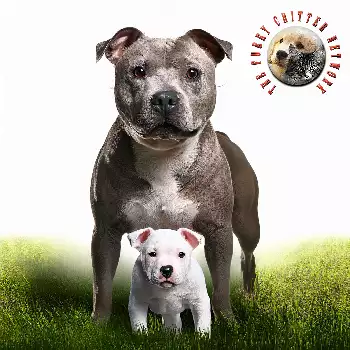American Kennel Club (AKC)
The AKC standard describes the Staffy as a smooth-coated dog with great strength for its size. The standard emphasizes that height at shoulder should be from 14 to 16 inches, with proportionate weight. Males typically range from 28 to 38 pounds, while females range from 24 to 34 pounds. The head should be short and deep with a broad skull, pronounced cheek muscles, and distinct stop. The muzzle is short with a black nose and tight lips.
Eyes must be dark and round, set to look straight ahead. Ears are rose or half-pricked, never fully dropped. The neck is muscular and slightly arched, widening toward the shoulders. The body features a level topline, broad front, deep brisket, and well-sprung ribs. The tail should be of medium length, low set, and tapering to a point, carried low. The gait should be free, powerful, and agile. The coat is smooth, short, and close. Colors acceptable include red, fawn, white, black, blue, or any of these colors with white, as well as brindle or brindle with white in any shade.
Fédération Cynologique Internationale (FCI)
The FCI standard, which serves as the foundation for many international kennel clubs, closely mirrors the original British standard. It emphasizes that the breed should be smooth-coated, well balanced, and of great strength for its size. Ideal height is 14 to 16 inches at the withers, with weight specifications similar to the AKC. The FCI standard particularly stresses the importance of balance and proportion over specific measurements.
The standard describes the desired temperament as traditionally of indomitable courage and tenacity, highly intelligent, and especially good with children. The head characteristics match other standards, emphasizing the short, deep skull with distinct stop and pronounced cheek muscles. The FCI standard notes that the gait should show drive from the hindquarters with free movement at the shoulder joints, neither rolling nor pacing. Any departure from the standard points is considered a fault, with the seriousness of the fault proportional to its degree and effect on health and welfare.
United Kennel Club (UKC)
The UKC recognizes the Staffy as a medium-sized, stocky, muscular dog with athletic ability and great strength for its size. The standard emphasizes that males should ideally stand 16 to 19 inches at the withers, while females should stand 15 to 18 inches. Weight should be proportionate to height, creating an overall balanced appearance. The UKC standard notes that the Staffy should never appear leggy or lack substance.
The head is characterized as medium length with a broad skull and very pronounced cheek muscles. The muzzle is short in comparison to the skull, with the distance from the stop to the tip of the nose approximately one-third the distance from the stop to the occiput. The jaw is strong with clean, tight lips. Eyes are round, of medium size, and dark in color. Ears are set high and may be natural or cropped. The neck is of medium length, muscular, and slightly arched. The body shows great strength with a level topline and broad, deep chest. The UKC standard allows for natural or docked tails. The coat should be smooth, short, and glossy, lying close to the skin.
Other Organizations
The Kennel Club (UK), which maintains the original breed standard, describes similar characteristics emphasizing a smooth-coated dog that is active and agile. The Australian National Kennel Council follows the FCI standard closely. The Canadian Kennel Club standard aligns with the British standard. Various specialty clubs, including the Staffordshire Bull Terrier Club of America and breed clubs in Europe, maintain standards that closely follow these major registry descriptions while sometimes adding specific guidance on movement, balance, and breed character that reflects regional breeding priorities.

